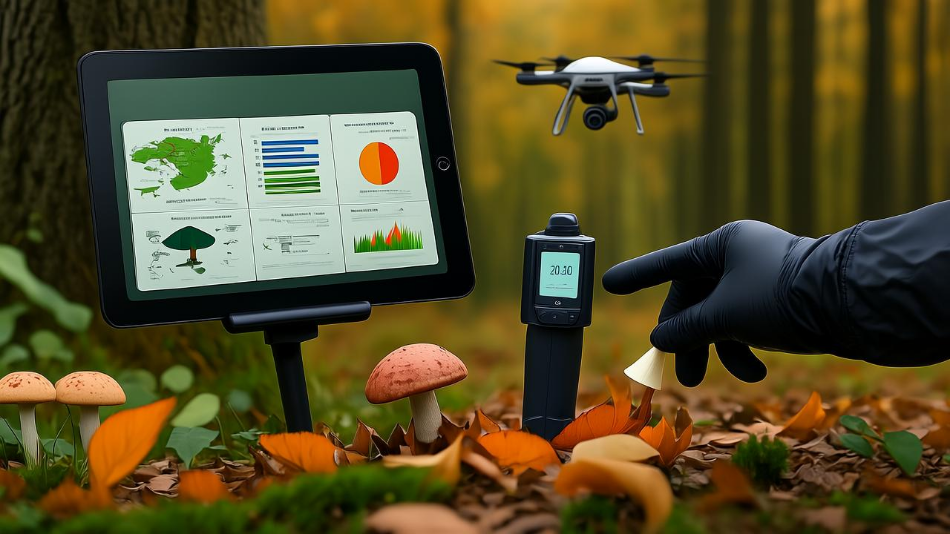The world of mycology and mushroom cultivation is undergoing a digital revolution. Thanks to technological advancements, it is now possible to collect, analyze, and interpret data with unprecedented precision, improving yield, quality, and sustainability in cultivation. Mushroom monitoring through sensors, apps, and dedicated software optimizes every growth phase, from spore germination to final harvest.
In this article, we will explore in detail how modern digital tools are transforming mycology, providing statistics, comparative tables, and real-world case studies. Discover how to use these technologies to achieve exceptional results, whether you're an amateur or a professional cultivator.
The importance of data in mushroom cultivation
In-depth analysis
- Humidity: mushrooms require relative humidity (RH) between 80% and 95%. A drop below 70% can halt growth, while excess humidity promotes unwanted mold.
- Temperature: each species has an optimal range. For example, Pleurotus ostreatus thrive between 18°C and 24°C, while Agaricus bisporus prefer 15°C–20°C.
- CO₂: concentrations above 2000 ppm inhibit the formation of fruiting bodies.
| Species | Humidity (%) | Temperature (°C) | CO₂ (ppm) |
|---|---|---|---|
| Pleurotus ostreatus | 85–95 | 18–24 | <1000 |
| Agaricus bisporus | 80–90 | 15–20 | <800 |
| Shiitake | 75–85 | 12–18 | <1200 |
Did You Know?: A 2022 study published in the Journal of Fungal Biology showed that IoT sensors improve yield by 30% compared to traditional methods.
Digital tools for mushroom monitoring
Technical Details
- Humidity and temperature sensors: Models like SensorPush or Grove – Temp & Humidity offer ±2% accuracy.
- CO₂ meters: The COZIR Ambient is among the most reliable for cultivation.
- Dataloggers: Devices like the HOBO MX1104 record data for long-term analysis.
Statistics:
- 65% of professional growers use at least one IoT sensor (Source: Global Mushroom Market Report 2023).
- Companies adopting digital monitoring reduce waste by 25%.
Software and apps for data analysis
Advanced Features
- Growth prediction: some algorithms estimate the optimal harvest time.
- Automated reports: generate charts on crop performance.
| Software | Price (monthly) | Key features |
|---|---|---|
| Mushroom Track | $29.99 | Predictive analytics, reports |
| Mycodo | Free (Open Source) | Cultivation automation |
The future of digital monitoring in mycology
Case Studies
- A Wageningen University project developed a model that identifies contamination with 90% accuracy.
- IBM Food Trust is experimenting with blockchain to trace mushroom supply chains.
Did You Know? By 2025, the smart-device market for mycology will be worth $1.2 billion (Source: Statista).
Mushroom monitoring through digital tools is no longer optional but a necessity for maximizing yield and quality. From IoT sensors to AI, the possibilities are endless. Start collecting data today and transform your cultivation!
For further insights, check the recommended links and stay updated on the latest innovations in digital mycology.
The fungal kingdom is a universe in continuous evolution, with new scientific discoveries emerging every year about their extraordinary benefits for gut health and overall well-being. From now on, when you see a mushroom, you will no longer think only of its taste or appearance, but of all the therapeutic potential it holds in its fibers and bioactive compounds. ✉️ Stay connected - Subscribe to our newsletter to receive the latest studies on: Nature offers us extraordinary tools to take care of our health. Fungi, with their unique balance between nutrition and medicine, represent a fascinating frontier we are only beginning to explore. Continue to follow us to discover how these extraordinary organisms can transform your approach to well-being.Continue your journey into the world of fungi










